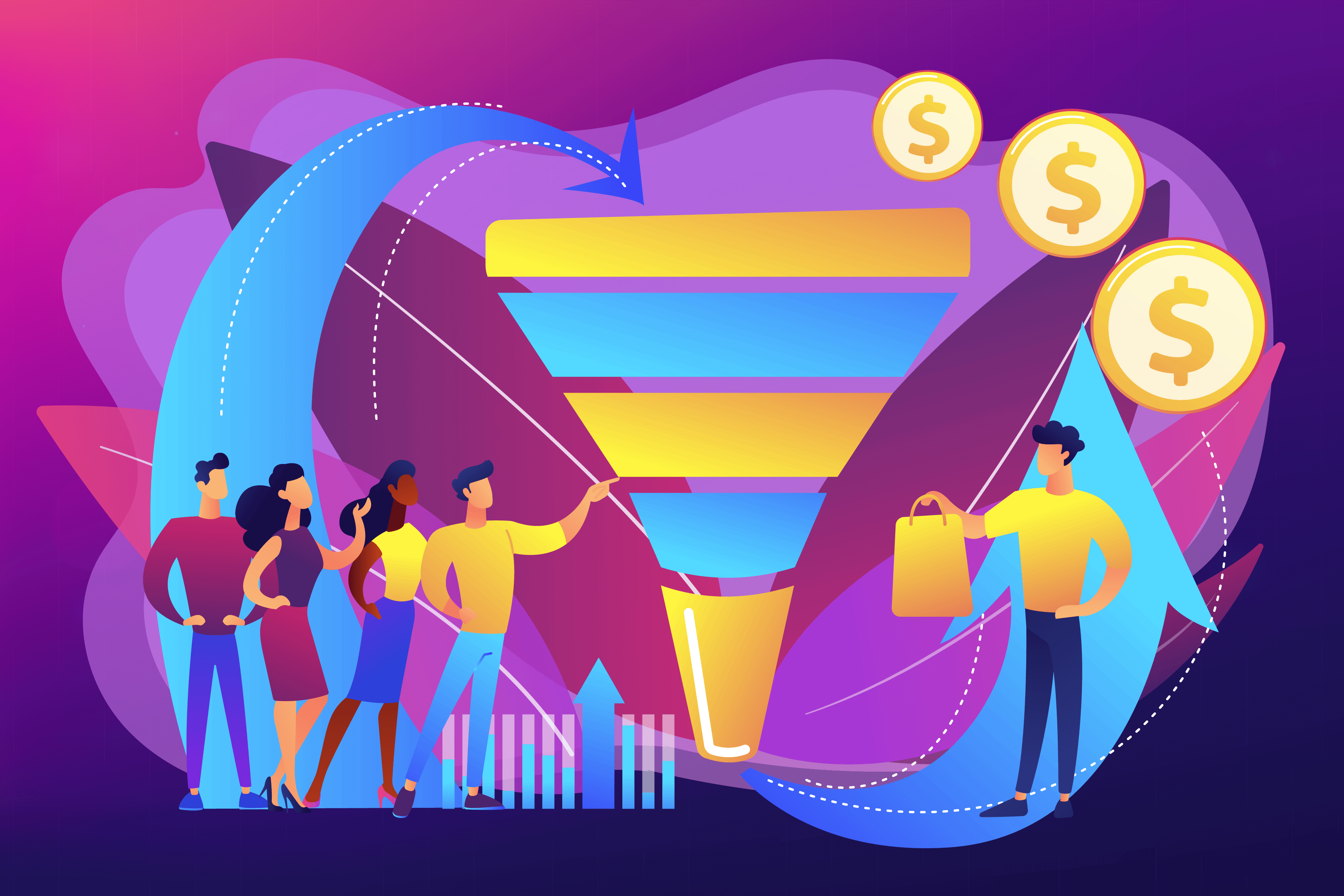Conversion Funnel: 9 Tips For Optimizing Your Conversion Rate

If you thought you could ignore it, you’re wrong! Whether you’re selling goods or services on your site, or if you’re using email marketing to reach your audience, the conversion funnel is your friend.
In fact, it’s highly likely that your site has not one but several conversion funnels.
Indeed, all your prospects and customers will not have the same level of maturity and may follow very different paths to conversion.
More than a just a “straight-line” to a sale or subscription, the funnel is a great way to learn about your customers’ browsing patterns and about what the typical buyer decision journey looks like.
Being well-acquainted with its characteristics is a prerequisite for successful optimization and for staying ahead of the competition.
In the following post, we will review some key facts about the conversion funnel and take a closer look at the various stages that make it up.
We’ll keep the best for the end with 9 tips on how to optimize your conversion funnels for optimize your conversion rate. Ready? Let’s jump straight into the funnel.
Short definition of the Conversion funnel
The conversion funnel refers to the step-by-step process that potential customers go through, from initial awareness to final purchase. It outlines the stages in which prospects are converted into customers, helping businesses understand and optimize their marketing efforts to drive successful conversions and increase revenue.
What is the Conversion Funnel?
Spoiler alert: there are almost as many funnels as there are businesses.
The conversion funnel is comprised of the steps a visitor takes to get to a site from an ad or organic search, for example, all the way to a sale.
The funnel metaphor illustrates the gradual decrease of visitors traveling through your site from point A to point B.
The further down the funnel, the smaller the number of visitors, and remember — not all journeys will lead to a conversion. While you will probably have seen many illustrations of the funnel, it’s important to remember that there are almost as many funnels as there are businesses.
Hence the visualization for the funnel will depend on your business objective(s), which could be:
- To sell goods or services
- To get a request for an estimate
- To increase newsletter subscriptions
- To increase downloads (reports, etc)
- etc
B2B, B2C and the Conversion Funnel
While the funnel is just as relevant for B2B as it is for B2C, it will look very different depending on whether you are targeting businesses or consumers.
For example, in B2C, the funnel will generally be simpler and shorter, because the purchase or subscription is often made on a whim or is at the very least highly subjective. A B2B conversion, however, will often be more pragmatic and business-driven. Building trust over time will therefore be crucial for B2B brands.
Conversion Funnel: What’s the Point?
2nd spoiler alert: there is no ideal conversion funnel — each objective and target has its own funnel.
Before you even get to conversion, the objective of the conversion funnel is to map out the various stages of the purchasing journey.
Once you have shed light on these stages, you can:
- Analyze friction points leading to exits (high bounce rate on a landing page, cart abandonment, etc)
- Qualify visitors at each stage of the journey (window-shopper, prospect, customer, etc)
- Optimize your funnel(s) with a view to increasing conversions
The differents stages of the Conversion Funnel
The conversion funnel consists of several stages that customers go through before making a purchase. These stages include:
- Awareness: At this stage, potential customers become aware of your brand or product. For example, a user might see a social media ad promoting a new smartphone.
- Interest: Once aware, customers show interest by conducting research. For instance, a customer might visit your website to read product reviews and compare features.
- Consideration: Customers evaluate their options and compare different products or services. As an example, a customer might compare prices and specifications between your smartphone and a competitor’s.
- Intent: At this stage, customers have a strong intention to make a purchase. They might add items to their shopping cart or proceed to the checkout page.
- Purchase: This is the final stage where the customer completes the transaction. They provide payment information and finalize the purchase of the chosen smartphone.
It’s important to note that the conversion funnel can vary depending on the industry and business model. Understanding each stage allows businesses to tailor their marketing strategies and optimize the user experience for better conversion rates.
Tips to optimize your Conversion Funnel
Retail, tourism, banking, insurance, online gaming… different verticals will have radically different conversion funnels.
It is, however, possible to map out an outline that will be meaningful to more than one type of business. This outline generally follows four key stages. But don’t forget that, depending on their level of maturity, it is not unusual for a visitor to skip a step or two.
For example, they may decide to complete a purchase without seeking out further information because they are already familiar with a brand and or a product.

1. Inspire visitors
For this first step, answer the questions that your visitors might have and build awareness around your product and brand. Make sure that your landing page displays content that clearly addresses the value around your product or services. In short, be educational.
2. Turn visitors into prospects
This second stage is all about trust. Your objective should be both simple and complex: obtain your visitors’ contact information either to stay in touch or personalize the experience. This is what is known as lead nurturing.
A great way to expand your database is to be generous with your resources:
- Newsletter with recommended reads or weekly tips
- Report or study based on your proprietary data or sector expertise
- Free tool or app
- Trial of your solution
- etc
3. Converting prospects into a customer
The third stage is critical.
Your prospect is shopping around for the most competitive offer and the one best suited to their needs — up to you to stand out in a crowd.
You can do this by:
- Simplifying the sales funnel
- Removing friction points
- Shortening the customer journey
4. Loyalty building: from customer to brand ambassador
You thought conversion was the last step in the conversion funnel? Not quite. The next step is to turn regular customers into loyal, returning customers.
This has two challenges:
- Encourage your customers to make a repeat purchase. Good news: it’s much easier to convert a customer who has already made a purchase on your site than a prospect.
- Encourage happy customers to review your goods or services. These recommendations will be very helpful when trying to convert first-time visitors.
How to Optimize the Conversion Funnel in 9 Key Steps
Are you still with us? Great — you’ve just made it through Stage One in real time.
Because we really want to get you through to Stage 2, we’ve compiled 9 tips to optimize the sales funnel, whatever business you’re in.
1. Make sure the message is clear
This seems basic and yet… Whether it’s free or not, your offering is the basis of your conversion funnel(s). For example, Amazon rewards its most loyal customers with free or fast shipping and an extended catalog with its Prime offering.
Defining your brand offering also means highlighting unique events around it — for example, a members-only sales to launch the holiday shopping season.
2. Define your objectives
Without a final objective, it will be difficult to map the route from start to finish — from the entry point to the post-conversion follow-up. It’s crucial you determine the main purpose of the conversion funnel in order to optimize the various stages leading to the end goal.
This could be a sale, download, subscription, social share, etc…
3. Personas are good, mindsets are better.
The Mindset methodology goes beyond traditional personas to deeply understand your prospects’ state of mind at each stage of the funnel.
Why are they on your site (information, purchase, comparison)? What is the context of their browsing (on mobile, at work, in the subway, in-store)?
Understanding your visitors’ mindset is the first step to making them digitally happy and turning them into converting customers.
4. Build a strong content strategy.
Let’s not beat around the bush. Without relevant content, your strategy won’t hold up.
Give visitors resources that provide a concrete answer to their challenges:
- Strengthen your brand image
- Position yourself as a thought leader in your sector
- Build up your database thanks to downloads (webinars, ebooks, etc…)
- Determine your visitors’ needs
In the travel industry, for example, inspirational content plays a key role in keeping visitors interested. This could mean suggesting itineraries for specific destinations, organizing trips around themes or offering advice about the best time to travel to a certain destination. In fact, 40% of all pages viewed* on travel sites contain inspirational content.

5. Streamline the UX
You might have the most attractive offer on the market and the most fascinating content, but your efforts won’t go far unless the user experience matches the expectations of your… visitors.
Here are a few common friction points you can fix as a matter of priority:
- Account creation: simplify account creation
- Checkout: drastically reduce the number of steps
- CTA: Create the perfect CTA
- Navigation: Structure your menu so it reflects the main categories on your site
- Product information: Pay special attention to descriptions, images, CTAs and remove any distracting elements
- Forms: Only include necessary fields
- Mobile: A visitor will leave a mobile page after 39 seconds — a mobile first approach is no longer a nice-to-have but is essential
- Experience: Suggest similar products throughout the customer journey and enable a wishlist function that visitors can easily share
6. Boost site performance
It’s a well-known fact that load times can heavily impact conversions. A study published by Google in February 2018 indicates that visitors are 32% more likely to leave a site if the page takes between 1 and 3 seconds to load.
7. Create elements of reassurance
It’s a saturated market and your offer and prices are fairly close to that of your competitors… If this is the case, reassurance elements could make all the difference, especially when it comes to decision making.
Make sure information and prices are clear:
- Be upfront about shipping costs
- Include several payment options
- Showcase customer reviews
- Etc
8. Determine entry points
As we’ve already mentioned, while objectives and targets are paramount factors of content creation it’s also important to build your strategy around the various channels that lead visitors to your website.
These touchpoints should be top of your mind when ironing the creases out of your purchase funnel:
- Adwords
- Retargeting
- Social platforms
- Organic search
- Influencer marketing
- Etc.
9. Test, test, test
You’ve put a lot of thought into your conversion funnel, your online content and your UX. Now what?
Now’s the time to analyze your traffic, bounce rate, click rate, session duration, conversions and exits at each stage of the funnel to identify any unanticipated obstacles to conversion. When armed with this knowledge, you can now test different variants of the funnel, modifying the copy, images, or repositioning CTAs, menus or customer reviews and seeing how this impacts conversions.
In conclusion, whatever goods or services you are offering online, conversion funnels are crucial to turning prospects into hopefully, loyal customers.
But building a conversion funnel is not enough. You have to underpin these efforts with a smart segmentation strategy and analyze the behavior of customers as they move closer to the end goal.
Here at Contentsquare we’re obsessed with the way people interact with digital platforms, and that’s why we’ve created a solution that empowers teams to optimize each phase of the buyer decision journey and maximize conversions.
We also believe sharing is caring so pay attention to this blog for more UX advice. 🙂
* Source: from a Contentsquare study based on 188 006 236 browsing sessions captured between October 1 and December 31st 2017.


